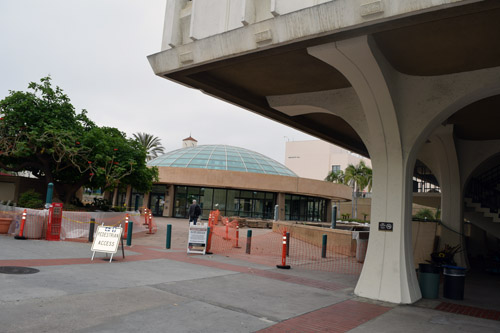
–30th in a series–
Exit 10, College Avenue, San Diego ~Jewish Historical Society of San Diego
By Donald H. Harrison
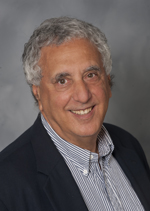
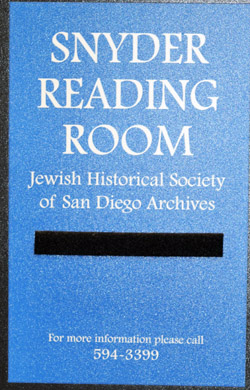 SAN DIEGO—Room 363 of the Love Library at San Diego State University is the home of the Jewish Historical Society of San Diego, which lovingly preserves the written records and photographs of this county’s Jewish community. The room is also known as the Irving and Sylvia Snyder Reading Room, co-memorializing a wife and a businessman who donated $50,000 to honor her.
SAN DIEGO—Room 363 of the Love Library at San Diego State University is the home of the Jewish Historical Society of San Diego, which lovingly preserves the written records and photographs of this county’s Jewish community. The room is also known as the Irving and Sylvia Snyder Reading Room, co-memorializing a wife and a businessman who donated $50,000 to honor her.
The reading room includes a lifetime collection of Judaic books that was donated to SDSU’s Lipinsky Institute for Judaic Studies by the family of Seymour Camp. The family advertised in the New York Times that they were looking for a suitable home for the books, and the then-director of the Institute, History Prof. Lawrence Baron, answered the advertisement.
Between its founding in 1980 and the approach of the year 2000, SDSU and the Jewish Historical Society of San Diego led separate existences.
The society had been founded in 1980 at the suggestion of Nathan and Sophie Gass, parents of member Arnold Gass, who were visiting from Lynn, Massachusetts, where they had founded their own local Jewish historical society. A small cadre of Jewish history enthusiasts—including Henry Schwartz, Mollie Harris, Audrey Karsh, and Prof. Abraham Nasatir of SDSU – promptly embraced the idea. Meeting at the Jewish Community Center, which then was located on 54th Street between El Cajon Boulevard and University Avenue, the Jewish Historical Society conducted business in a low key fashion.
Henry Schwartz popularized the society by writing regularly about episodes in San Diego Jewish history for the fortnightly newspaper Israel Today, which later changed its name to San Diego Jewish Times.
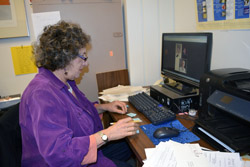
Stan and Laurel Schwartz were not related to Henry Schwartz, and it was by coincidence that after Henry died, people of the same surname were elevated to the leadership.
The couple had moved to San Diego from New York State where, at colleges located miles apart, she had majored in art and minored in Judaic Studies, and he had majored in business. Laurel and Stan met in Israel while taking a two-week bus tour sponsored by the American Jewish Congress. Laurel had accompanied an aunt, while Stan had traveled on his own. There were three busloads on the tour, and Stan and Laurel were the only passengers then in their 20s.
As might be imagined, they gravitated toward each other, and eventually, encouraged by busloads of would-be shadchans, decided to sit with each other for the balance of the tour. Thereafter the progress of their relationship was a regular topic of conversation for the other travelers. Months after returning to New York, they announced their engagement, to the accolades of their former traveling companions. The American Jewish Congress was so excited by the successful match that the organization began to advertise singles tours to Israel.
History was among the young couple’s common interests, and they attended annual meetings held in cities around the country of the American Jewish Historical Society, at which researchers presented papers on local topics.
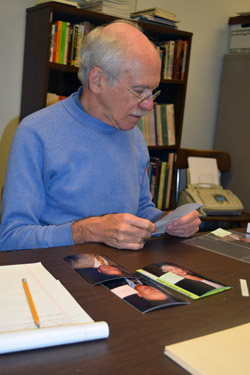
When the Schwartzes decided in 1978 to move to San Diego for its weather, their parents Anne and Martin Press and Mildred and Harry Schwartz, as well as Stan’s grandmother, Ida Steinberg, soon decided to follow them. Although they initially worked at other jobs, Laurel and Stan found a new passion in 1989 – buying and selling Judaic books.
“When we moved out here we were interested in antique furniture and we visited a lot of antique shops,” Stan recalled. “I noticed Jewish books lying on the shelves. I thought ‘what good are the books doing in this place?’ So we would buy the books and I had a small collection and I was working in computer sciences at the time, on a military contract. I got laid off and Laurel said ‘why don’t you start selling some of the books, and I did.” Thus the business known as Schwartz Judaica was born.
After Henry Schwartz died, Stan and Laurel rose to top leadership roles. At their behest, the organization began to collect dues, more extensively publicize its activities, and expand its membership. They invited both scholars and long-time San Diegans to address their society.
Among the speakers were Harriet Rochlin, author of Pioneer Jews; Elana Saad, who made a study of the Jews of Tijuana; and Vernon Kahn, whose autobiography told of creating Vernon’s Delicatessen and the North Park Bakery.
But times, they were changing. Jews were moving from East San Diego to La Jolla and to northern San Diego County communities located along the Interstate 5 and the Interstate 15. The center of Jewish population was moving farther and farther away from the old JCC at 4079 54th Street, which had been dedicated back in 1958. The new Lawrence Family JCC was built in the 1980s, and although the East San Diego community tried hard to hold on and keep the 54th Street JCC open, eventually expenses outran their ambitions. The property was sold in the 1990s to a church, which itself was later torn down to make way for a housing development.
Meanwhile, in 1991, Rabbi Morton J. Cohn, who had been the senior rabbi of Congregation Beth Israel, and later in his career the founding rabbi of Temple Emanu-El, died in 1991, followed five years later by his wife, Sally. Their children, closing up his home, invited the Jewish Historical Society to take custody of his papers. “Pick them up today,” the rabbi’s son, Mort Cohn Jr., asked.
Rabbi Cohn “had five 4-drawer filing cabinets filled with his papers,” Laurel recalled. “We went out to his house on Barbarossa Drive, realized that this was a very large collection, and called Congregation Beth Israel, and asked if they could help us with this.”
Stan picked up the story: “I was friends with Stuart Simmons (then executive director of Beth Israel) and he sent over several men who worked there with a truck.”
It meant first taking all the papers out of the filing cabinets and putting them into boxes, then moving the empty cabinets and filled boxes to Congregation Beth Israel (then located at 3rd Avenue and Laurel Street, the present home of Ohr Shalom Synagogue), where the contents of the boxes were put back into the filing cabinets and stored in a garage area.
The collected papers of Rabbi Morton J. Cohn thus became the first collection of the Jewish Historical Society.
As the year 2000 approached, marking the 150th year of Jewish settlement in San Diego, the Jewish Historical Society of San Diego and the Lipinsky Institute for Judaic Studies at SDSU came to a symbiotic understanding. The Jewish Historical Society could keep its archives in the Snyder Reading Room, where its staff and volunteers could curate the collections, placing documents and photographs into acid-free folders and cataloging the collections.. When these are ready, the Jewish Historical Society formally donates each collection, with archival notes, to the Special Collections and University Archives at SDSU’s Love Library.
With such transfer of ownership, the collections are assured a permanent home, and will be available to scholars.
As of this writing, there are 85 collections that have either been donated to SDSU’s Special Collections or are in the process of being curated by the Jewish Historical Society, which is always on the look out for more.
Among other contributors who followed the lead of the Cohn family was Seymour Okmin, who gave the Historical Society records and photographs from the Weinberger Lodge of the B’nai B’rith. Lenore Fefferman of B’nai B’rith Women donated her collection. Longtime Cantor Sheldon Merel of Beth Israel, when he moved to Seacrest Village Retirement Community in Encinitas, operated by the Hebrew Homes, couldn’t take all his material with him, so he donated “pictures, notices, programs, and CDs,” said Laurel. “He wanted access to the collection, so we photographed every page of his scrapbooks and we gave him a digital file.”
In the instance of Ruth Doris Jacobson, who was the commander of Post 185 of the Jewish War Veterans, the family allowed the Historical Society to digitally photograph her papers and scrapbooks, but kept the originals in their possession.
The Jewish Federation of San Diego County turned over to the Jewish Historical Society 20 boxes of records including over 30,000 photographs dating back to the 1940s. And, the most recent collection obtained by the society included some of the papers of former San Diego City Councilwoman Abbe Wolfsheimer Stutz and her father, Col. Irving Salomon. The colonel was an internationalist who was appointed by President Dwight D. Eisenhower to the U.S. delegation to the United Nations, and who hosted Eleanor Roosevelt at his Rancho Lilac in Valley Center, and who was the first Jewish layman to become a papal knight. Other of Salomon’s papers were donated to the Valley Center History Museum, near Escondido.
Today, Laurel Schwartz serves as the Jewish Historical Society’s archivist and her husband, Stan, as its president. The Lipinsky Insitute for Judaic Studies has been replaced by the Jewish Studies Program of SDSU, headed by Prof. Risa Levitt Kohn.
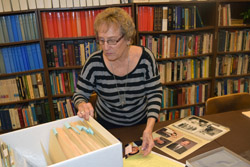
When I visited the reading room recently, Stan and Laurel were both there along with the society’s treasurer Gerri Brech. Together the society’s three officers were sorting through thousands of photographs from the Jewish Federation of San Diego, captioning those that they could, and putting all of them into acid-free sleeves.
Brech, I learned, is the former Gerri Goldstein, whose public school education was at a trio of schools named for U.S. Presidents – Andrew Jackson Elementary School, Woodrow Wilson Junior High, and Herbert Hoover High School. From there she went to San Diego City College, becoming a medical assistant, and after raising her family, continued her education at Grossmont College and San Diego State University. She eventually became a preschool teacher at the 54th Street JCC and after that worked at the JCC Building Fund Campaign Office.
Her family were members of Tifereth Israel Synagogue when it was located on 30th Street, but by the time she was raising a family of her own, she was a member of Temple Emanu-El, now located in the Del Cerro area. After her family grew up, she moved to Rancho Bernardo, becoming a member of nearby Temple Adat Shalom in Poway.
She recalled that teens in the 1950s liked to go to drive-in restaurants at which car hops would bring food orders to your car, some of them racing to and fro on roller skates. Girls, she recalled, went to the drive in restaurants with other girls, and boys with boys, and they would check each other out, not unlike the characters in the movie American Graffiti. Brech also was a member of B’nai B’rith Girls, which met at Temple Beth Israel, and on a few occasions was persuaded to be a hostess at dances sponsored by the Jewish Welfare Board for military personnel.
Brech said she volunteers for the Jewish Historical Society because “I like everything Jewish” and because she greatly admires Stan and Laurel Schwartz for their dedication to the cause of historic preservation. “They tell me what to do and I do it,” she laughed.
Other regulars: Al Kohn and his late wife Fern; and native San Diegan Marilyn Smith Tom.
The society welcomes volunteers and researchers and material donations. Call or email for an appointment via laurelschwartz@cox.net or phoning (619) 232-5888,. Its collections can be accessed via two websites: www.jewishstudies.sdsu.edu/archives.htm and www.jhssandiego.pastperfect-online.com
Next: Hillel of San Diego State
*
Harrison is editor of San Diego Jewish World. You may comment to him at donald.harrison@sdjewishworld.com, or post your comment on this website, provided that the rules below are observed.
__________________________________________________________________
Your comment should be followed with this information: Your full name, your city and state (or country) of residence. Letters lacking such information will be automatically deleted. San Diego Jewish World is intended as a forum for the entire Jewish community, whatever your political leanings. Letters may be posted below provided they are responsive to the article to which they are affixed, and civil in their tone. Ad hominem attacks against any religion, country, gender, race, sexual orientation, or physical disability will not be considered for publication. There is a limit of one letter per writer on any given day.
__________________________________________________________________
Excellent, comprehensive, interesting article about the great job Laurel and Stan are doing, heading the San Diego Jewish Historical Society. What a wonderful series, Don. Eileen